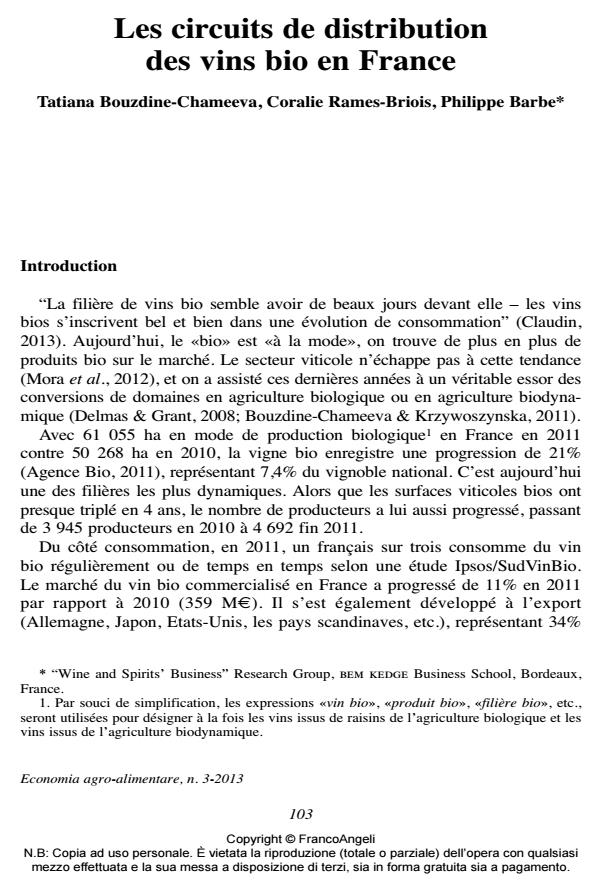The distribution channels of bio wines in France
Journal title ECONOMIA AGRO-ALIMENTARE
Author/s Tatiana Bouzdine-Chameeva, Coralie Rames-Briois, Philippe Barbe
Publishing Year 2014 Issue 2013/3
Language French Pages 21 P. 103-123 File size 1128 KB
DOI 10.3280/ECAG2013-003007
DOI is like a bar code for intellectual property: to have more infomation
click here
Below, you can see the article first page
If you want to buy this article in PDF format, you can do it, following the instructions to buy download credits

FrancoAngeli is member of Publishers International Linking Association, Inc (PILA), a not-for-profit association which run the CrossRef service enabling links to and from online scholarly content.
Since 2006 the conversion of vineyards to organic or biodynamic vineyards has been accelerating in France, and the annual rate of conversion varies between 20- 25% per year, attaining the total surface of 61.055 ha of bio vineyards in 2011. This growth is even more striking in the light of the shrinking total surface of vineyards and the decreasing trend of wine consumption in France. In this challenging context, we attempt to analyze which of the classic wine distribution channels are conducive to French bio wine producers. The study is grounded in a series of interviews in several regions of France on a variety of distribution practices employed by natural wine producers. The research methodology employs content analysis and cognitive mapping technique. While the bio wine distribution system appears to be diversified and mobilizes all the classic channels, direct sales and export appear to be of particular relevance. Our findings confirm the impact of extra production costs (from 15 to 30%) on the choice of an appropriate channel. This extra production cost, explained mainly by higher labor costs and partly justified by the higher quality of wines, typically results in higher prices which the final consumer must pay. In this case direct sales could be seen the most remunerative as a producer’s margins are not squeezed in intermediate transactions. A closer relation between a producer and a consumer also adds value to the product: consumers perceive bio wine primarily as a wine, a cultural product which witnesses the diversity of terroirs. The presented analysis of bio wines distribution channels will allow practitioners to better adjust their distribution strategies.
Keywords: Bio wines, distribution channels, wine production, strategic decisions, Bordeaux, France
Jel codes: L66, Q13, M11
Tatiana Bouzdine-Chameeva, Coralie Rames-Briois, Philippe Barbe, Les circuits de distribution des vins bio en France in "ECONOMIA AGRO-ALIMENTARE" 3/2013, pp 103-123, DOI: 10.3280/ECAG2013-003007